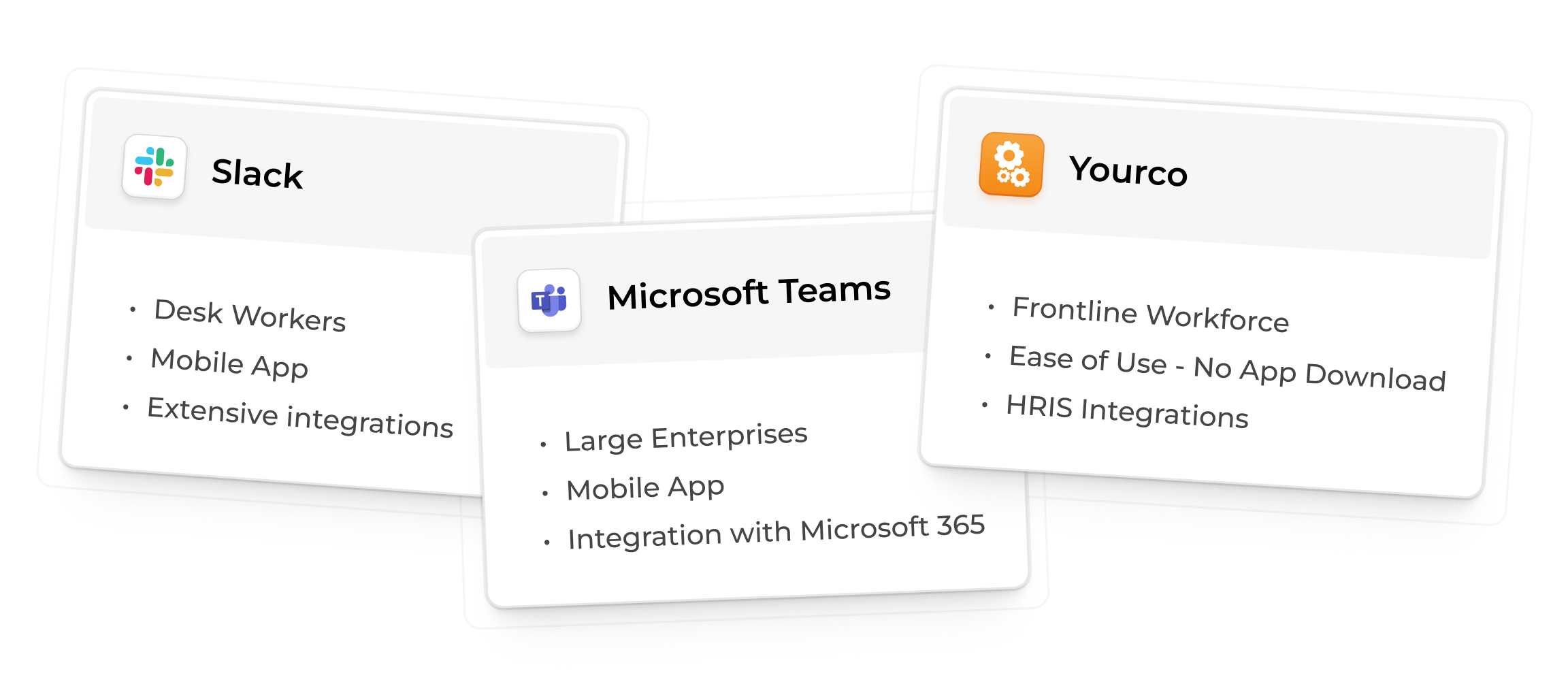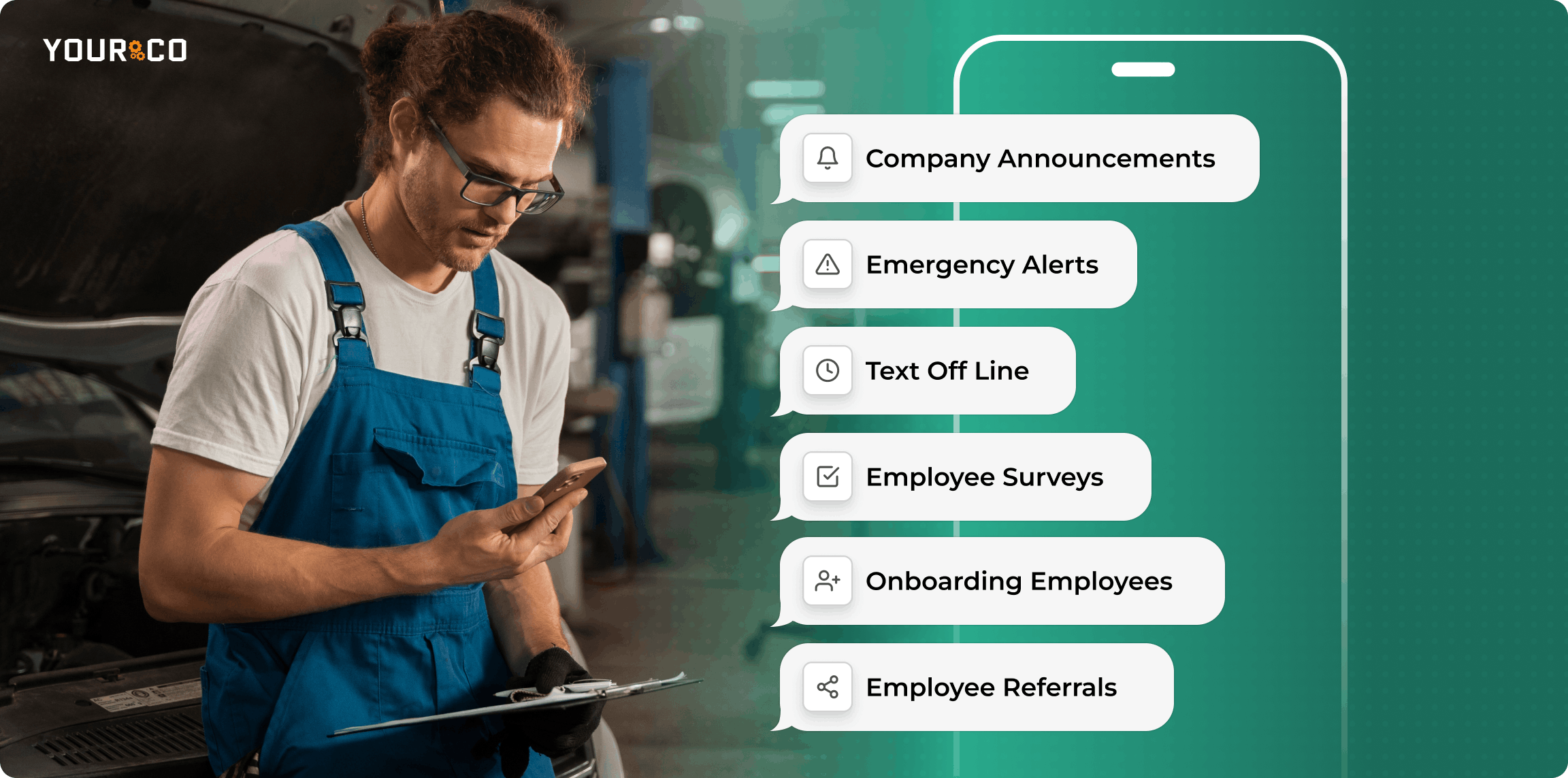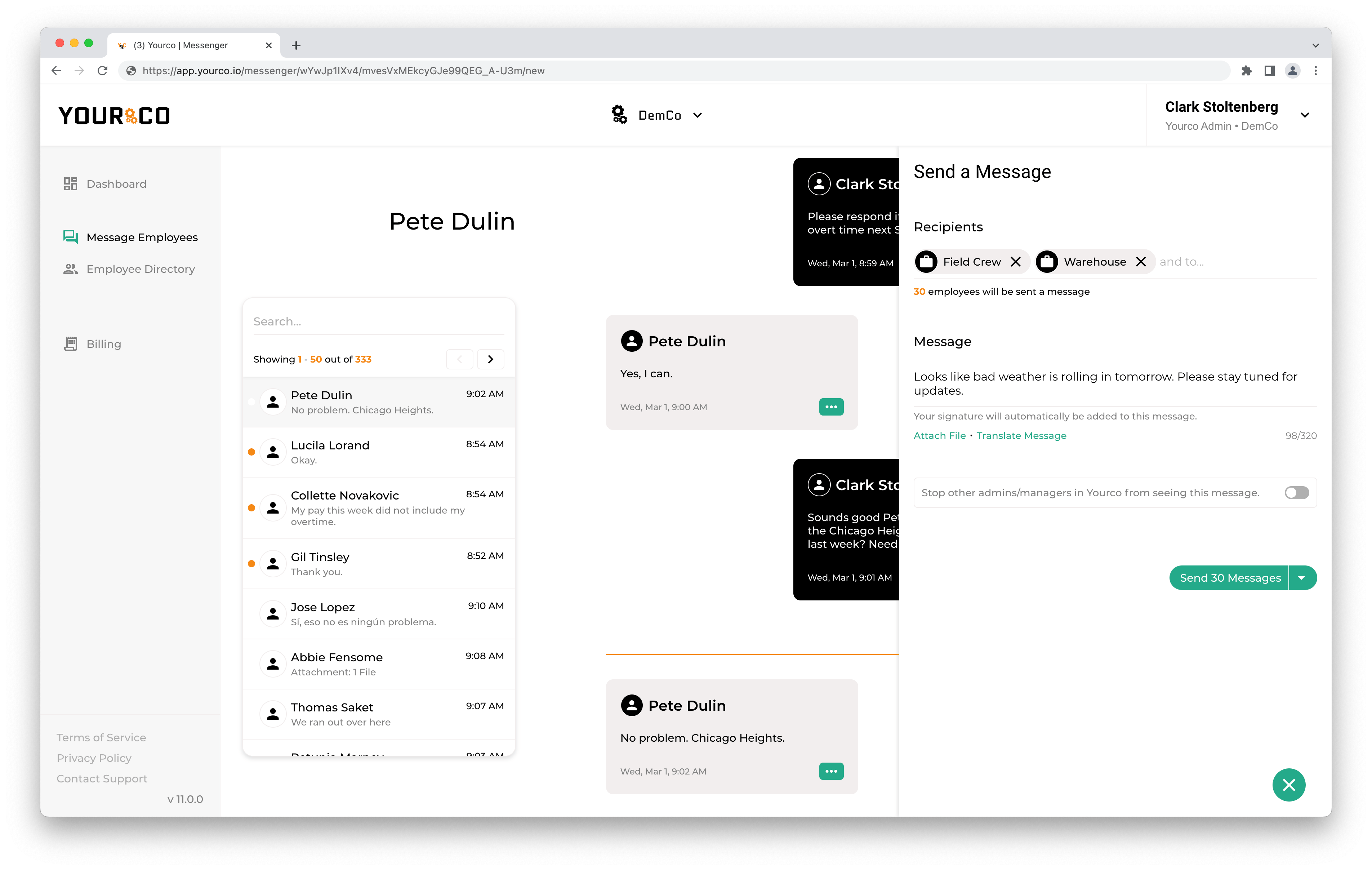Internal Text Communication

Internal Text Communication
Email, texting, WhatsApp, Microsoft Teams, Slack… The list of available internal communication methods for businesses goes on and on. For many, it’s easy to stick with what’s standard—email. But is that really the best choice? Email overload bombards employees with irrelevant information, making it harder to find important messages. In 2021, global email users received a total of 319.6 billion messages per day. Out of those hundreds of billions of emails, over 45% of them were spam. Users stop paying attention to new messages because so many aren’t worth opening. Some industries even experience an open rate of as little as 50%. And that’s for internal messages—not marketing emails.
Communication breakdowns happen more often in industries that rely on non-desk employees. Workers that are out in the field or on the floor make up 72% of the workforce. That means that almost three-quarters of employees don’t have regular access to a computer and can’t—or won’t—check email.
As an alternative, many HR departments and managers are switching to messaging apps like Slack and WhatsApp to reach non-desk employees. While they have some accessibility improvements over email, non-desk employees still resist these apps. According to Forbes, 91% of smartphone users hate being required to download an app to use a product or service (and there are still many people without smartphones or reliable internet).
Breakdowns in internal communication can cause safety issues, lost productivity, and increased employee turnover. So, what can be done? At Yourco, we’ve found that businesses have the most success by using an internal SMS text-messaging system to communicate with non-desk employees. In this guide to internal communication between management and non-desk employees, we’ll dive deeper into available tools and how you can establish communication that is simple, accessible, inclusive, and effective.
What Is the Purpose of Internal Messaging?
Internal messaging allows you to instantly communicate with employees. This enables you to get project updates, be notified when employees are using sick time, and communicate other essential information in real time. Effective internal messaging systems, like two-way text communication, also document the messages between you and your employees.
What Are the Advantages of Having Good Communication Skills?
Effective internal communication makes it easier for employees to do their jobs and helps you keep track of progress. It also enables both employers and employees to be aware of sudden changes so they can adapt. Here’s a breakdown of how good communication with non-desk employees can benefit your business:
Respond to Emergencies
When working out in the field, non-desk employees can encounter a variety of emergencies. Injuries, equipment breakdowns, inclement weather, and more can require your immediate attention. If you have effective communication methods set up, you can reduce the negative impact from emergencies. However, poor communication can lead to employee harm, lost productivity, and lawsuits.
Text messaging provides the fastest way to reach your entire workforce during emergencies. With a 95% open rate within three minutes, SMS ensures critical information reaches employees quickly when seconds count.
Track Progress
Customers can call at any time to check on how much progress you’ve made on their project. If you aren’t communicating with your employees, you may just answer whatever the schedule says, which could be inaccurate. If you tell a customer that their project is on time when it’s actually behind, they’ll be dissatisfied. If you aren’t telling them when you’re ahead of schedule, then you’re missing out on potential referrals for excellent service. Good communication doesn’t just have the advantage of telling you how much progress is being made—it tells you why.
Increase Employee Retention
Industries that rely on non-desk employees, like hospitality, agriculture and manufacturing, can experience high turnover rates. In fact, supermarkets and restaurants faced turnover rates of 100% in 2018. That’s almost double the average turnover rate for all industries in 2021, which was 57.3%. While lower wages, inconsistent schedules, and a lack of benefits drive employees to leave many deskless jobs, communication issues also run rampant.
By improving internal communication, companies can boost employee engagement and reduce turnover rates.
Monitor Staffing
Non-desk employees need to come in to get the job done, but life happens. Kids’ doctor appointments, car problems, sick days, and more can keep an employee from showing up. These events usually happen at the last minute, so it’s important for employees to be able to communicate when they can’t come to work. That way, you can adjust—whether that means calling someone in to cover their shift, canceling a job, or changing expectations for progress.
Text messaging enables quick coordination for shift management and schedule changes. Organizations can instantly reach out to employees to cover shifts or communicate schedule updates, ensuring smooth operations.
Having a simple, familiar text-communication system that your managers and non-desk employees participate in keeps your teams informed and projects moving forward. Yourco accomplishes this by providing a platform from which administrators can send out mass or individual messages. Employees can then respond as though they were having a normal text conversation.
What Are Examples of Internal Communication?

When it comes to choosing the best internal communication system for your business, you have a lot of options. The best for you will depend on what your employees will actually use and what your managers can keep track of.
Different types of communication tools come with different benefits and requirements to use. You’re likely familiar with the following options, but when’s the last time you evaluated if you’re using the most effective communication tools for your business?
SMS Text Messaging
Can employers text employees? Absolutely! Text messages are one of the most effective communication tools for reaching non-desk employees. Text messages are easy to send and receive, don’t require an app to use, and have an open rate of 95% within just three minutes after being received. You still have to be careful, though, as directly texting your employees can cause some issues. For example, you wouldn’t want your employees to see your personal phone number, and you don’t want to deal with cumbersome group texts. Yourco works around these downsides by assigning your business a unique phone number and sending out mass messages to individuals instead of into a group chat.
Messaging Apps
Apps like Slack, WhatsApp, and Microsoft Teams are designed to emulate a text-messaging experience with grouping and media-sharing capabilities. Most messaging apps don’t use a phone number. Instead, users sign up for an account to send and receive messages through Wi-Fi or cellular data. Unfortunately, these apps don’t engage employees because they require downloading and creating a new account. Like email, they also drain data plans.
Email tends to be the go-to for internal communication. With the ability to attach files, send mass messages, and the option to reply to sender or reply all, email is a versatile tool. However, this method can get clunky when communicating with non-desk employees. Email requires a browser or app, so users can’t send or receive messages without a smartphone. Email also relies on Wi-Fi or cellular data.
Internal Text Communication via SMS
SMS-based internal communication offers a powerful direct channel between management and employees, providing unparalleled speed and accessibility for organizations with significant non-desk workforces.
SMS for internal communication uses text messaging as a primary means of sharing information, updates, and directives within an organization. Unlike email or intranets, SMS reaches employees directly on their mobile devices, ensuring critical information arrives promptly.
The Benefits of SMS in Internal Communication
SMS communication offers significant advantages over traditional methods, especially for engaging non-desk workers.
Higher Engagement Rates
SMS boasts remarkably high engagement compared to other channels:
- Open rates for SMS consistently range between 90% and 98%, far surpassing email's average of 20-32%
- About 62% of SMS recipients read and respond within minutes, with average response times around 90 seconds
- Email response times lag significantly, often exceeding 90 minutes
These statistics highlight the immediacy and effectiveness of SMS in reaching employees without regular access to email or company intranets.
Simplicity and Ubiquity
SMS stands out for its simplicity and universal accessibility:
- No implementation, training, or app downloads required
- Works on all mobile phones, regardless of model or data plan
- No internet connection necessary, making it ideal for field workers or those in areas with limited connectivity
This simplicity ensures all employees, regardless of technical proficiency or device type, can receive and respond to important communications quickly.
Enhanced Reach and Accessibility
For organizations with significant non-desk workforces, SMS provides unparalleled reach:
- Works on all phones, from basic models to smartphones, ensuring no employee is excluded
- Messages can be delivered and read in real-time, even where email or app notifications might be missed
- The ubiquity of mobile phones means employees always have access to company communications, whether on the factory floor, in the field, or on the move
This enhanced accessibility proves particularly valuable for industries like healthcare, retail, and manufacturing, where timely information significantly impacts operations and safety.
How Can I Manage Text Messages? With Yourco!
Texting is by far the best way to communicate with non-desk employees, but you shouldn’t just text them directly from your phone. Starting group chats or working with one-way texting services won’t work, either. Here’s why:
Yourco vs. Direct Texting
With direct texting, you need to add all employee contact information manually and have no practical way to send mass texts outside of a group-chat format. Yourco lets you upload your employee database once and send individual or mass texts that look like one-on-one conversations to recipients. Additionally, with automatic contact syncing with your HRIS, Yourco ensures new hires are reachable on day one and terminated contacts are instantly removed to avoid compliance risks.
Yourco vs. Group Chats
Group chats are difficult to keep track of and often go ignored. They also expose each employee’s personal contact information. Yourco sends mass messages as individual conversations and protects employee privacy. Granular permission controls restrict who can broadcast to large groups, reducing noise and message fatigue.
Yourco vs. Other Texting Services
Most other texting services are built for marketing and aren’t optimized for receiving responses. Yourco enables and encourages two-way communication and stores message history so you can reference important information later. Detailed analytics—open rates, average response time, and sentiment scoring—also help managers refine messaging strategy over time.
By choosing an employee texting platform like Yourco, you can implement an effective text-communication strategy that is secure, compliant, and tailored to your organization's needs.
Should Managers Communicate Through Text Messages?
Yes, most managers should communicate with non-desk employees through a text-messaging platform. Text messaging isn’t just effective; it can also be secure when you take the proper precautions. For example, when you send out a mass message with Yourco, employees can’t see their coworkers’ phone numbers.
Best Practices for Effective SMS Communication
Following best practices maximizes the effectiveness and engagement of your SMS strategy.
Content Guidelines
Keep your messages clear, concise, and actionable:
- Focus on essential information only
- Use short, direct sentences
- Include clear calls-to-action
Your employees are likely reading these messages on the go, so craft content that's easily understood at a glance.
Engaging Content Creation
Boost engagement by incorporating two-way communication features:
- Use polls and surveys to gather feedback
- Encourage responses with questions
- Provide options for further information
Poll capabilities allow you to quickly gauge employee sentiment or collect important data, turning passive communication into active engagement.
Frequency and Timing
Strike the right balance in message frequency:
- Respect work hours and personal time
- Avoid message fatigue by limiting non-essential communications
- Follow TCPA timing restrictions (no messages between 9 pm and 8 am)
Send messages only when the information is timely and relevant. Over-communication can lead to employees ignoring important updates.
Examples of Well-Crafted SMS Communications
- Shift Change Alert:
"URGENT: Your shift tomorrow (5/15) has changed to 2 PM - 10 PM. Reply YES to confirm." - Safety Reminder:
"SAFETY FIRST: Heat advisory in effect. Remember to stay hydrated and take regular breaks. Reply HELP for heat stress symptoms." - Team Meeting Notification:
"TEAM MEETING: Tomorrow 9 AM in Conference Room A. Topic: Q2 Goals. Can't attend? Reply NO for recap email." - Emergency Update:
"ALERT: Office closed due to severe weather. Work from home if possible. Stay safe. Updates at [link]" - Quick Survey:
"QUICK POLL: How was today's training? Reply 1 (Poor) to 5 (Excellent). Your feedback helps us improve!"
The key to successful SMS communication is relevance, timeliness, and respect for your employees' time and attention.
What Can Text Messaging Be Used to Communicate?
Text messaging can handle all of the necessary communication between HR and non-desk employees. Here are some of its main uses:

Company Announcements
When you have something big to announce, you want people to listen. Text messaging is the most-responded-to form of communication (other than face-to-face). Whether sharing news of your business’s expansion, new uniform guidelines, or celebrating high performance, texting ensures your message is received.
This extends to day-to-day communications with use cases like:
- HR communications: Send reminders about benefits enrollment, policy changes, or important deadlines
- Scheduling changes: Notify employees about shift updates or last-minute coverage needs
- Operational updates: Keep staff informed about new procedures, goals, or company-wide initiatives
Employee Alerts
The unexpected happens. With text messaging, you have the widest reach in the most locations. Whether you lose power in a warehouse and need to send teams home for the afternoon or you need to shut down a construction site due to inclement weather, text messaging is fast—and people actually check them!
For urgent employee alerts, SMS is ideal for:
- Safety incidents: Quickly notify employees about potential hazards or emergency situations
- Weather emergencies: Alert staff about office closures or modified schedules due to severe weather
- IT outages: Inform employees about system downtime or critical technical issues
Text Off Line
Having a dedicated line that employees can use to let you know that they won’t make it into work makes it easier for them to notify you. It also makes it easier for you to track who’s coming in and who isn’t because there will be a readable record instead of a voicemail.
Employee Surveys
Employees that feel heard stick around longer. Asking for feedback makes your employees feel heard and valued, and people like to keep working where they feel respected. By texting out links to surveys, you can also get ahead of minor problems before they cause major disruptions.
Onboarding Employees
When you hire a new employee, there’s a lot to go over. Important deadlines for filing paperwork, instructions on where to show up for work, and what employees need to bring with them can all be sent through text. So can links to necessary documents and welcoming and training videos.
Employee Referrals
When you have a new job posting, you can send a text message to encourage your current employees to apply. You’ll have more in-house talent to choose from. If you decide to open up interviews to external applicants, your employees can forward the job posting to their network, so you’ll once again have a larger applicant pool.
To maximize SMS communications impact:
- Categorize messages by urgency and relevance
- Use clear, concise language optimized for mobile devices
- Integrate SMS with other communication channels
- Regularly gather feedback to refine your approach
Thoughtful SMS implementation for these use cases significantly enhances internal communication effectiveness, leading to better-engaged employees and streamlined operations.
How Do I Send an Employee a Text Message? With Yourco
Now that you’ve seen the benefits of texting your non-desk employees, let’s go over how to actually set up your communication system by going through Yourco’s process.
Step 1
After signing up for an account, your business is assigned a unique phone number. We put your new number through an extensive vetting process with the major service providers so you don’t have to worry about important messages getting flagged as spam.
Step 2
Import your employees’ contact information. You can either do this by importing a spreadsheet or connecting to your payroll software or HRIS. For the best results, you should have your employees listed with their first name, last name, phone number, and the groups and departments they belong to.
Step 3

Grant administrator and manager access. Admins can add and remove employees from the system and send and receive messages from all employees. They can also grant manager access and specify which employees and groups they can send and receive messages from. Managers can only send and receive messages from employees and groups that admins have granted them access to. Administrators and managers can be HR professionals, team supervisors, or operational managers. Business owners and IT professionals may also need access in certain cases.
You also have the ability to designate different locations, so you don’t have to worry about the manager at one plant sending location-specific information to a team at another plant. From the administrators and managers that have access to your dashboard, you can also choose specific managers to be able to monitor and communicate with different teams. For example, this enables your HR team to communicate sensitive information with employees without worrying about a team manager seeing it.
Step 4
To send a message, select the Message Employees section on your dashboard, and then click Create a Message. You can then select a specific employee to send a message to. Your entire message history, which saves automatically, will be available to look back on, too.

Step 5
How can I send a mass text to my employees? From Create a Message, you can also send a mass text message to employees. Instead of selecting an individual employee, choose a team or department, and your message will be sent to each member of that group. When your employees get the message, it will appear as an individual conversation, so they won’t be able to see other recipients’ phone numbers. This measure protects the privacy of your non-desk employees. They also won’t have to keep track of the chaos that group chats inevitably fall into.

Step 6
When employees text your unique business phone number, you’ll receive a notification in your dashboard. Don’t worry, Yourco is designed to be as convenient for administrators and managers as it is for your employees. That’s why it’s a browser-based dashboard that is mobile-friendly. You can also set up notifications to alert you through text messages and/or email.
Yourco: Your Solution for Two-Way Communication with Non-Desk Employees
Effective internal communication is more critical than ever. With the majority of the workforce being deskless, traditional methods like email fail to reach employees promptly. Text messaging offers a powerful solution, providing instant, reliable, and engaging communication.
Yourco does what email and group-chat apps can’t—enable and encourage communication between administrators and non-desk employees. If non-desk employees don’t check email or resist downloading apps, or if you struggle to react to emergencies and staffing changes, Yourco can help.
Contact us to see how we can overcome your communication challenges.


